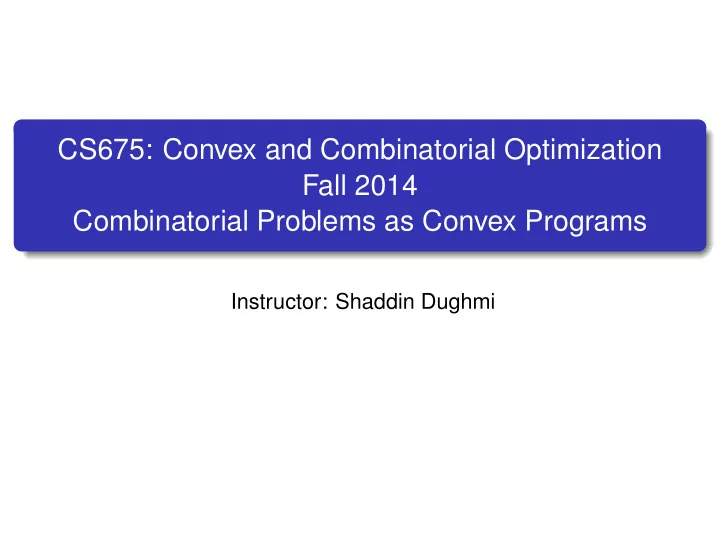

CS675: Convex and Combinatorial Optimization Fall 2014 Combinatorial Problems as Convex Programs Instructor: Shaddin Dughmi
The Max Cut Problem Given an undirected graph G = ( V, E ) , find a partition of V into ( S, V \ S ) maximizing number of edges with exactly one end in S . 1 − x i x j maximize � ( i,j ) ∈ E 2 subject to x i ∈ {− 1 , 1 } , for i ∈ V.
The Max Cut Problem Given an undirected graph G = ( V, E ) , find a partition of V into ( S, V \ S ) maximizing number of edges with exactly one end in S . 1 − x i x j maximize � ( i,j ) ∈ E 2 subject to x i ∈ {− 1 , 1 } , for i ∈ V. Instead of requiring x i to be on the 1 dimensional sphere, we relax and permit it to be in the n -dimensional sphere. Vector Program relaxation 1 − � v i · � v j maximize � ( i,j ) ∈ E 2 subject to || � v i || 2 = 1 , for i ∈ V. v i ∈ R n , � for i ∈ V.
SDP Relaxation Recall: An n × n matrix Y is PSD iff Y = V T V for n × n matrix V When diagonal entires of Y are 1 , V has unit length columns Equivalently: PSD matrices encode pairwise dot products of columns of V Recall: Y and V can be recovered from each other efficiently
SDP Relaxation Recall: An n × n matrix Y is PSD iff Y = V T V for n × n matrix V When diagonal entires of Y are 1 , V has unit length columns Equivalently: PSD matrices encode pairwise dot products of columns of V Recall: Y and V can be recovered from each other efficiently Vector Program relaxation 1 − � v i · � v j � maximize ( i,j ) ∈ E 2 subject to || � v i || 2 = 1 , for i ∈ V. v i ∈ R n , � for i ∈ V. SDP Relaxation 1 − Y ij maximize � ( i,j ) ∈ E 2 subject to Y ii = 1 , for i ∈ V. Y ∈ S n +
SDP Relaxation 1 − Y ij maximize � ( i,j ) ∈ E 2 Y ii = 1 , for i ∈ V. subject to Y ∈ S n + Randomized Algorithm for Max Cut Solve the SDP to get Y � 0 1 Decompose Y to V V T 2 Pick a random vector r on the unit sphere 3 Place all nodes i with v i · r ≥ 0 on one side of the cut, and all 4 others on the other side
SDP Relaxation 1 − Y ij maximize � ( i,j ) ∈ E 2 Y ii = 1 , for i ∈ V. subject to Y ∈ S n + Randomized Algorithm for Max Cut Solve the SDP to get Y � 0 1 Decompose Y to V V T 2 Pick a random vector r on the unit sphere 3 Place all nodes i with v i · r ≥ 0 on one side of the cut, and all 4 others on the other side Lemma The SDP cuts each edge with probability at least 0 . 878 1 − Y ij 2 Consequently, by linearity of expectation, expected number of edges cut is at least 0 . 878 OPT .
Lemma The SDP cuts each edge with probability at least 0 . 878 1 − Y ij 2 We use the following fact Fact For all angles θ ∈ [0 , π ] , θ π ≥ 0 . 878 · 1 2(1 − cos ( θ )) to prove the Lemma on the board.
Recommend
More recommend